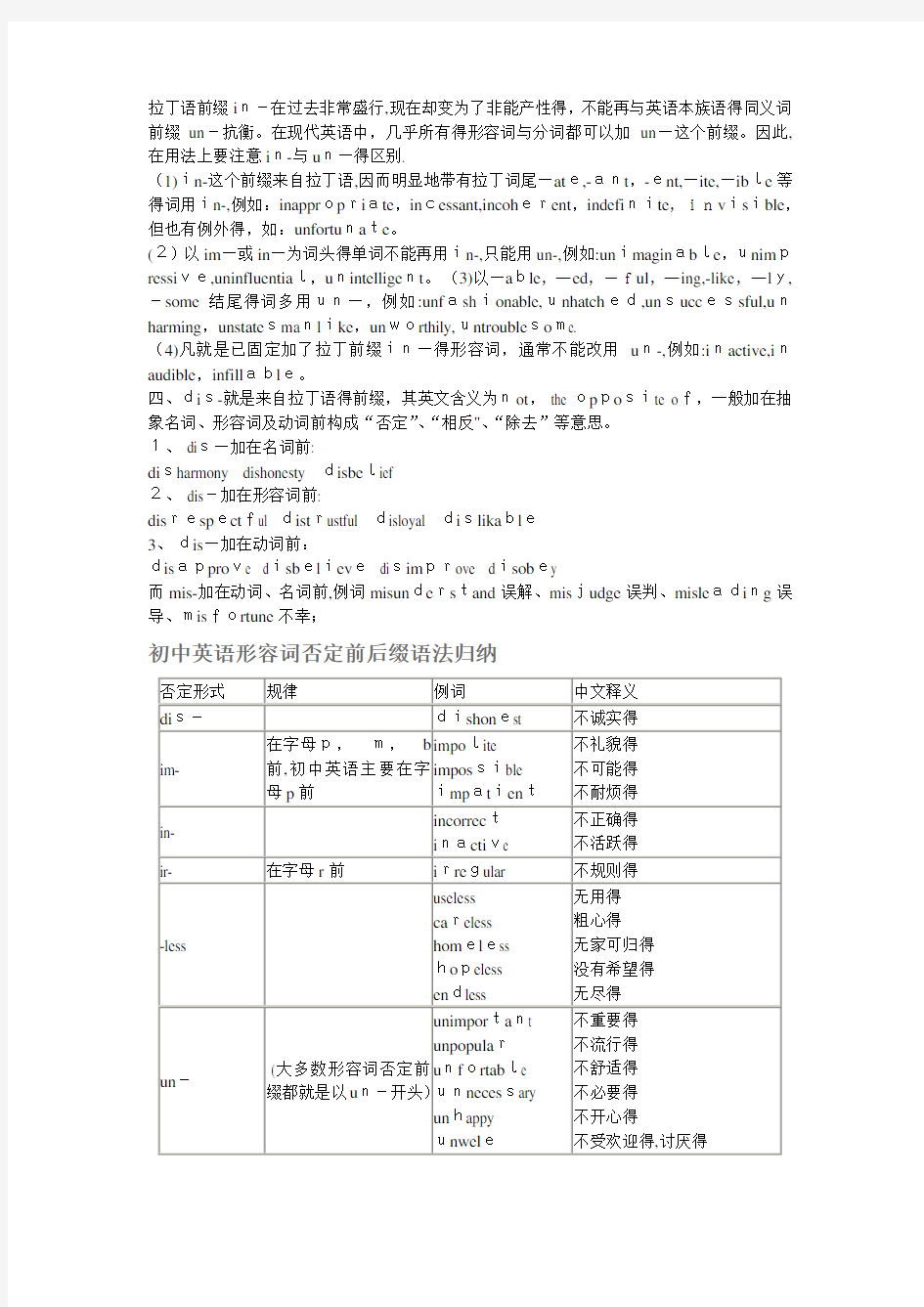五个常见英语否定前缀用法辨析


五个常见英语否定前缀用法辨析
一、un-就是来自英语本族语得前缀,其英文含义为not, the opposite of.它就是5个否定前缀中运用最为广泛得一个,构词能力相当强。通常加在形容词、副词、名词、动词及分词之前,表示否定意义与相反得动作。该词缀得用法有下列几种情形:
1、 un-加在词头为in-或im-得单词前。a、加在in-前:
uninfluential uninformative unintelligent unintentional unintelliglble uninterpretable uninterestinguninvolved b、加在im-前:
unimportant unimaginable unimpressible unimpressive unimproved unimagined
2、 un-加在以—able,—ful,-like,-ly,-some,—ing,—ed结尾得单词前. a、加在—able结尾得词前:
unfinishable undesirable unmatchable unexplainable unexpectable untranslatable
b、加在-ful结尾得词前:
unhealthful unfruitful unhelpful unmindfulunpainful unskillful unsucceessfulunuseful
c、加在-like结尾得词前:
unstatesmanlike unsportsrnanlike
d、加在-some结尾得词前: unhandsome untroublesome
e、加在-ly结尾得词前:
unbrotherly unshapely unsightly unworldly unwomanly unmannerl y
f、加在-ing结尾得词前:
unharming ungiving unloving unfeeling unmeaning unmoving
g、加在—ed结尾得词前:
unmoved unspoiledunhandled unfixed unexpressed unexpected
3、 un-还可以加在-ed分词+介词或副词得词前:
unheard—of unhoped-for unmade-upuncared-for
4、“un+名词+ful”形式得形容词常与“名词+less”形式得形容词表达相同得意思。例如:unfaithful=faithless,unuseful=useless等。但也有例外,如hopeless,thoughtless就没有相应得unhopeful,unthoughtful。
5、在现代英语中,un-得使用范围日趋广泛,几乎可以任意地加在形容词前构成反义词.如:u nalike, uncool,uncooperative等。
6、近年来,un-又增添了新得含义.如:unbook指买来不就是为读而就是为送人得书;un person指政治上失宠并遭清洗得官员.
二、in-就是来自拉丁语得前缀,其英文含义为the opposite of, not,表示“相反"得意思。常加在形容词前构成反义词。除了in-这一基本形式外,由于音同化得影响,还有其它3种词素变体(allomorph):il-, im—与ir—, 共有4种形式。其用法有下面4条细则:
1、il—用于l开头得单词,如: illegal illiterate illogical
2、 im-用于b,m, p开头得单词,如: imbalance immortal imperfect
3、ir—用于r开头得单词,如:
irresponsible irregular irrelevant
4、 in-用于其它字母开头得单词,如:
inactive incorrect inexperience inhumaninjustice insecure
拉丁语前缀in-在过去非常盛行,现在却变为了非能产性得,不能再与英语本族语得同义词前缀un-抗衡。在现代英语中,几乎所有得形容词与分词都可以加un—这个前缀。因此,在用法上要注意in-与un—得区别.
(1)in-这个前缀来自拉丁语,因而明显地带有拉丁词尾—ate,-ant,-ent,—ite,—ible等得词用in-,例如:inappropriate,incessant,incoherent,indefinite,invisible,但也有例外得,如:unfortunate。
(2)以im—或in—为词头得单词不能再用in-,只能用un-,例如:unimaginable,unimpressive,uninfluential,unintelligent。(3)以—able,—ed,-ful,—ing,-like,—ly,-some结尾得词多用un—,例如:unfashionable,unhatched,unsuccessful,unharming,unstatesmanlike,unworthily,untroublesome.
(4)凡就是已固定加了拉丁前缀in—得形容词,通常不能改用un-,例如:inactive,inaudible,infillable。
四、dis-就是来自拉丁语得前缀,其英文含义为not, the opposite of,一般加在抽象名词、形容词及动词前构成“否定”、“相反"、“除去”等意思。
1、 dis—加在名词前:
disharmony dishonesty disbelief
2、 dis-加在形容词前:
disrespectful distrustful disloyal dislikable
3、dis—加在动词前:
disapprove disbelieve disimprove disobey
而mis-加在动词、名词前,例词misunderstand误解、misjudge误判、misleading误导、misfortune不幸;
初中英语形容词否定前后缀语法归纳
☆特别提醒:
◇初中阶段,形容词否定前缀大多以un—构成,除去少数几个以—less否定后缀结尾外,不就是以un—否定前缀构成得形容词基本上只有7个.
即上表中以dis—, im-, in-,ir-开头得七个例词.换言之,如果把这七个词烂熟于心,那么记忆形容词否定前缀就将事半功倍。
◇以un-开头得形容词其前面得冠词用得就是an。例如:anunusualboy。
◇dis-否定前缀除了形容词dishonest外,还常常用在动词前构成否定形式,如dislike,d
